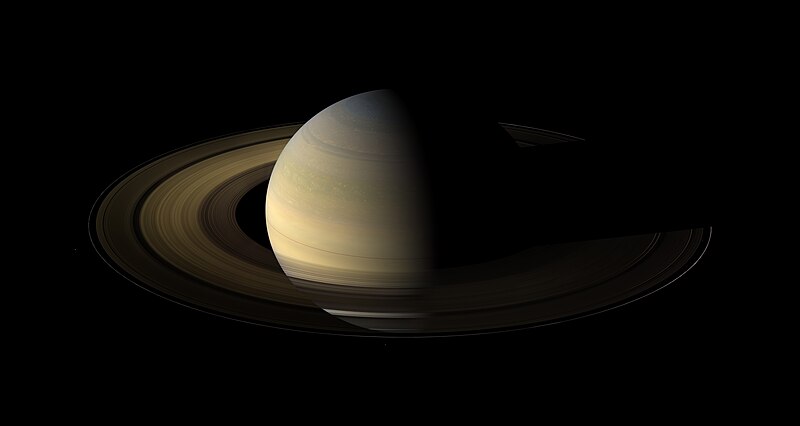Ficheiro:Saturn, its rings, and a few of its moons.jpg

Dimensões desta antevisão: 800 × 426 píxeis. Outras resoluções: 320 × 170 píxeis | 640 × 341 píxeis | 1 024 × 545 píxeis | 1 280 × 681 píxeis | 2 560 × 1 363 píxeis | 7 227 × 3 847 píxeis.
Imagem numa resolução maior (7 227 × 3 847 píxeis, tamanho: 3,58 MB, tipo MIME: image/jpeg)
Histórico do ficheiro
Clique uma data e hora para ver o ficheiro tal como ele se encontrava nessa altura.
| Data e hora | Miniatura | Dimensões | Utilizador | Comentário | |
|---|---|---|---|---|---|
| atual | 16h08min de 7 de junho de 2014 |  | 7 227 × 3 847 (3,58 MB) | NH2501 | Lower compression, taken from http://www.dlr.de/media/en/desktopdefault.aspx/tabid-4986/8423_read-12880/8423_page-2 |
| 18h24min de 21 de setembro de 2009 |  | 7 227 × 3 847 (1 018 kB) | Originalwana | {{Information |Description={{en|1=Seen from our planet, the view of Saturn's rings during equinox is extremely foreshortened and limited. But in orbit around Saturn, Cassini had no such problems. From |
Utilização local do ficheiro
As seguintes 2 páginas usam este ficheiro:
Utilização global do ficheiro
As seguintes wikis usam este ficheiro:
- ar.wikipedia.org
- تيتان (قمر)
- زحل
- هايبريون
- عملاق غازي
- إنسيلادوس
- برنامج فوياجر
- بيونير 11
- كاسيني-هويجنز
- أطلس (قمر)
- أقمار زحل
- برومثيوس (قمر)
- باندورا (قمر)
- بان (قمر)
- ميماس
- S/2009 S 1
- جانوس (قمر)
- S/2007 S 2
- دافنيس (قمر)
- هاتي (قمر)
- بيستلا (قمر)
- S/2007 S 3
- S/2006 S 3
- S/2004 S 7
- فارباوتي (قمر)
- طرقيق
- ديون (قمر)
- سكول (قمر)
- جريب (قمر)
- نارفي (قمر)
- فورنجوت (قمر)
- هيروكين (قمر)
- آيجير
- سكاثي (قمر)
- بيرجلمير (قمر)
- تريمر
- جارنساكسا (قمر)
- كاري (قمر)
- مونديلفاري (قمر)
- سورتور (قمر)
- بيبهيون (قمر)
- لوج (قمر)
- فينرير (قمر)
- إريابوس
- يمير (قمر)
- سوتونجر (قمر)
- كيفيويك (قمر)
- بالياق
- S/2004 S 4
- S/2006 S 1
- S/2004 S 13
Ver mais utilizações globais deste ficheiro.


